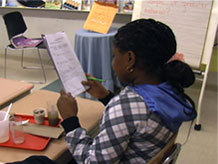What happens when we add earth materials to water?
3. Make meaning
Purpose of the discussion
The purpose of the discussion is for students to explain displacement in the case of a granular material (e.g., gravel or sand) being added to water in a graduated cylinder. Return to the investigation question:
What happens when we add earth materials to water?
Engage students in the focus question
Ask students about their predictions and results.

- What did you observe when you added materials to the water in the cylinder?
- Did any of your observations surprise you?
Students are typically surprised by what happened when they added the gravel. The combined volume seems to have come up short.
- Did you all get the same result?
- What do you think happened? Why doesn't the combined volume equal 80 cubic centimeters?
Let students brainstorm some ideas. Maybe they measured wrong. Maybe some of the water soaked into the gravel or splashed out of the cylinder. Or maybe the empty spaces between the pieces of gravel have something to do with it.
Remind students what they learned early on about granular materials like sand and soil. They are made up of grains of earth materials surrounded by empty spaces that can fill with air or water. Explain that when a granular material is put in water, the air escapes from the container and the water takes its place. This means that the rise in water level we see in the cylinder represents only the volume of the solid, rocky material not the original volume, which was the gravel plus the spaces.
40cc sample:
- Approximately 24cc of the bulk volume of gravel, pebbles, sand is rock and 16 cc are air.
- 16cc of the water settle into the air spaces (displaces the air) leaving the other 24cc above the rock grains.
To consolidate the understanding, and for a formative assessment, ask students to answer the Reflection Questions in their notebooks [Does 40cc plus 40cc equal 80cc?]. When they are done, conduct the experiment detailed there and discuss the results. As time permits, discuss the observation that the amount of air in 40cc of sand seems to be equal to the amount of air in gravel.
How can that be? Shouldn't there be more air in the gravel? Aren't the spaces between the pieces of gravel much bigger?
Summarize the discussion and recap the investigation
Use the language that the students used to explain what happens to the volume when solid, liquid, and granular materials are added to a liquid material.
Make the following points as you wrap up the investigation.
- When a solid is added to a liquid, the combined volume is the sum of the separate volumes.
- When a liquid is added to a liquid, the combined volume is the sum of the separate volumes.
- When a granular material is added to a liquid, the combined volume is equal to the sum of the separate volumes minus the volume of the air between the grains in the sample.



